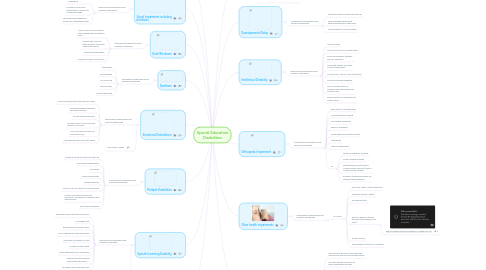
1. Hearing Impairment
1.1. Intervention/Modifications and Assistive Technology
1.1.1. Interpreters
1.1.2. Closed Captioning
1.1.3. visual aids
1.1.4. lecture notes
1.1.5. hearing aids-enhanced audio technology
1.1.6. Sign Language
1.1.7. Preferred seating
2. Visual Impairment including blindness
2.1. Intervention/Modifications and Assistive Technology
2.1.1. Video with voice over explanations of what is happening
2.1.2. Provide multi-sensory experiences to touch and manipulate things
2.1.3. Use braille technologies for books and integrated images
3. Autism
3.1. Intervention/Modifications and Assistive Technology
3.1.1. Know the student's needs
3.1.2. Give more time to complete assignments
3.1.3. Have set routines and schedules
3.1.4. Give clear, step by step instructions
3.1.5. Allow for social interaction with others
3.1.6. Provide feedback with positive praise
3.1.7. Collaborate with family and other teachers
3.1.8. Know student's strength and weaknesses to keep them engaged
3.2. Case study: Maggie
4. Deaf-Blindness
4.1. Intervention/Modifications and Assistive Technology
4.1.1. Hand in hand communication- sign language with a student's hand
4.1.2. Provide multi-sensory experiences to touch and manipulate objects
4.1.3. Use braille technologies
4.1.4. Enhanced audio or visual tools
5. Deafness
5.1. Intervention/Modifications and Assistive Technology
5.1.1. Interpreters
5.1.2. Sign language
5.1.3. Use visual aid
5.1.4. Lecture notes
5.1.5. Closed captioning
6. Developmental Delay
6.1. Intervention/Modifications and Assistive Technology
6.1.1. Know the student's needs and their IEP
6.1.2. Work with their parents and other professionals in the school
6.1.3. Allow students to use computers
7. Emotional Disturbance
7.1. Intervention/Modifications and Assistive Technology
7.1.1. Know the student and their specific needs
7.1.2. Provide immediate feedback and positive praise
7.1.3. Provide behavior support
7.1.4. Talk with family to find out what is going on at home
7.1.5. Use structure and routine to build social skills
7.1.6. Help them become more self-aware
7.2. Case Study: Megan
8. Intellectual Disability
8.1. Intervention/Modifications and Assistive Technology
8.1.1. Teach life skills
8.1.2. Allow more time to complete tasks
8.1.3. Know the student's and their specific needs/IEP
8.1.4. Work with parents and other school professionals
8.1.5. Provide Clear, step by step instructions
8.1.6. Provide immediate feedback
8.1.7. Give concrete hands on examples and opportunities to practice skills
8.1.8. Break directions or activities into smaller steps
9. Multiple Disabilities
9.1. Intervention/Modifications and Assistive Technology
9.1.1. Know the student's needs and their IEP
9.1.2. Encourage independence
9.1.3. Be flexible
9.1.4. Modify assignments
9.1.5. Address behavior
9.1.6. Allow AT use for student to communicate
9.1.7. Practice and reinforce skills and directions- Give hands on examples and opportunities
9.1.8. Play to their strengths
10. Orthopedic Impairment
10.1. Intervention/Modifications and Assistive Technology
10.1.1. Extra time to complete tasks
10.1.2. Offer preferential seating
10.1.3. Occupation Therapists
10.1.4. Physical Therapists
10.1.5. Adapt physical education classes
10.1.6. Give Breaks
10.1.7. Speech Pathologists
10.1.8. AT
10.1.8.1. speech recognition software
10.1.8.2. screen reading software
10.1.8.3. augmentative and alternative communication devices (such as communication boards)
10.1.8.4. academic software packages for students with disabilities
11. Other health impairments
11.1. Intervention/Modifications and Assistive Technology
11.1.1. ex. ADHD
11.1.1.1. Post clear, step by step instructions
11.1.1.2. Know the student's needs
11.1.1.3. Set specific tasts
11.1.1.4. Allow for physical activity (perhaps have a balance ball chair)
11.1.1.4.1. https://www.youtube.com/watch?v=AdxduVSxUNo
11.1.1.5. Follow routines
11.1.1.6. Allow children to work on computers
12. Specific Learning Disability
12.1. Intervention/Modifications and Assistive Technology
12.1.1. Know the student and their needs/ IEP
12.1.2. Use bigger print
12.1.3. Break things into smaller steps
12.1.4. Use computers for writing activities
12.1.5. Use audio recording for notes
12.1.6. Provide modified tests
12.1.7. Teach organization and study skills
12.1.8. Establish positive working relationship with family
12.1.9. Be flexible and allow more time
12.2. Case Study: Nick
13. Speech or Language Impairment
13.1. Intervention/Modifications and Assistive Technology
13.1.1. Know the student and their needs/IEP
13.1.2. Speech Pathologist
13.1.3. Allow student to use AT to communicate
13.1.4. Provide modified tests if necessary
13.1.5. Use state/district resources
13.1.6. Collaborate with parents and other teachers/school professionals
14. Traumatic Brain Injury
14.1. Intervention/Modifications and Assistive Technology
14.1.1. Find out as much as you can about the child’s injury and his or her present needs.
14.1.2. Give the student more time to finish schoolwork and tests.
14.1.3. Give clear step by step directions
14.1.4. Show the student how to perform new tasks. Give examples
14.1.5. Have consistent routines
14.1.6. Check understanding
14.1.7. Help student stay organized and give examples
14.1.8. Allow breaks
14.1.9. Stay informed about how they are doing at home and in school
14.1.10. Be flexible and allow more time to complete tasks
